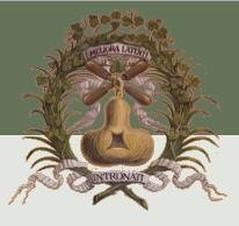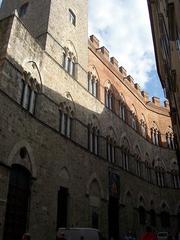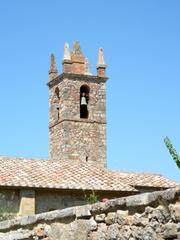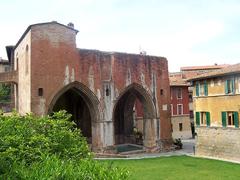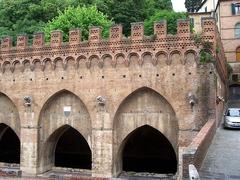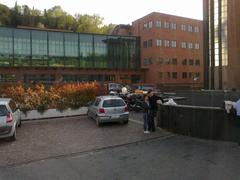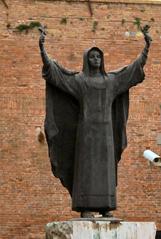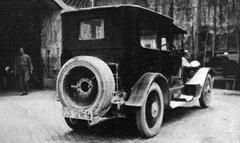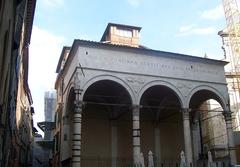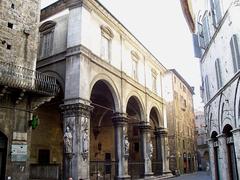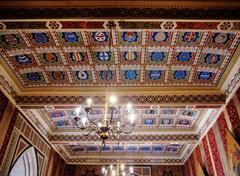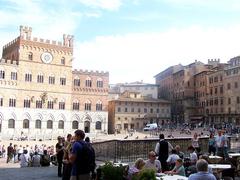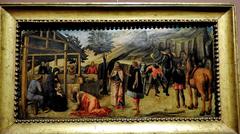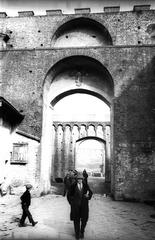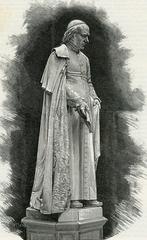Palazzo Vestri Visiting Hours, Tickets, and Siena Historical Sites Guide
Date: 14/06/2025
Introduction: Discovering Palazzo Vestri in Siena
Nestled in Siena’s historic Contrada della Torre, Palazzo Vestri is an architectural and cultural gem that offers a rare glimpse into the city’s evolution from medieval grandeur to Enlightenment innovation. Distinguished by its unique helicoidal (helical) ramp—a stairless winding ascent within its 18th-century walls—Palazzo Vestri stands apart from more famous landmarks like the Palazzo Pubblico or Siena Cathedral, yet is no less significant for those seeking to uncover Siena’s hidden layers. The palace’s connection to the Italian Risorgimento and its role in Siena’s social fabric make it a compelling destination for architecture enthusiasts, history buffs, and cultural travelers alike.
Access to Palazzo Vestri is limited due to its status as a private residence, but special events and guided tours occasionally offer opportunities for the public to explore its remarkable interior. This guide provides comprehensive information on its history, architecture, visiting hours, ticketing, accessibility, and its place within Siena’s broader UNESCO World Heritage-listed urban landscape. For the most current details and visual resources, official sources such as Visit Siena Official and UNESCO World Heritage are highly recommended.
Table of Contents
- Introduction
- Origins and Architectural Evolution
- The Helical Ramp: Innovation and Symbolism
- Historical Residents and Risorgimento Connections
- Context within Siena’s Urban Fabric
- Architectural Details and Preservation
- Social and Cultural Significance
- Visitor Information: Hours, Tickets, and Accessibility
- Siena’s Broader Heritage and Nearby Sites
- Practical Travel Tips
- Frequently Asked Questions (FAQ)
- Visual Gallery and Media
- Summary and Conclusion
- Sources and Official Links
Origins and Architectural Evolution
Palazzo Vestri exemplifies Siena’s 18th-century architectural ingenuity, situated within Contrada della Torre—one of the city’s most storied neighborhoods. Known locally as “il palazzo senza scale” (the palace without stairs), its defining feature is the helicoidal ramp that spirals from the courtyard to the upper floors (Visit Siena Official). This innovative design marked a departure from typical staircases and reflected contemporary ideals of rationality, efficiency, and accessibility. The palace’s robust exterior is softened by the graceful curves of the ramp, blending Enlightenment sensibilities with Sienese tradition.
The Helical Ramp: Innovation and Symbolism
The ramp inside Palazzo Vestri is both a technical and symbolic marvel. Entirely step-free, it enables smooth movement between floors and is believed to have been constructed to accommodate an infirm resident who could be carried in a sedan chair. This unique solution anticipated modern concerns about accessibility and efficiency, making the palace a point of architectural fascination (Visit Siena Official). The ramp’s continuous curve and gentle incline are rare in Siena, further elevating the significance of the building within the city’s architectural landscape.
Historical Residents and Risorgimento Connections
Palazzo Vestri’s historical resonance extends beyond its walls. It was home to notable figures such as Pietro Vestri, a Garibaldian patriot, and his daughter Baldovina Vestri, an influential woman in the Risorgimento—the movement for Italian unification. Their stories link the palace to pivotal moments in national history, and Baldovina’s legacy is honored locally, including at the Laterino cemetery’s “Quadrilatero dei garibaldini” (Terre di Siena). The palace thus serves as a microcosm of Siena’s engagement with the political and social changes of the 19th century.
Context within Siena’s Urban Fabric
Located in the Contrada della Torre, Palazzo Vestri sits within the UNESCO-listed historic center of Siena. The city is renowned for its medieval core, the fan-shaped Piazza del Campo, and vibrant traditions like the Palio di Siena (UNESCO World Heritage). While the palace’s 18th-century origins distinguish it from the city’s predominantly medieval architecture, it contributes to Siena’s layered urban tapestry—an enduring dialogue between tradition and progress.
Architectural Details and Preservation
Palazzo Vestri’s façade is marked by harmonious proportions, red brickwork, and travertine stone accents—hallmarks of Siena’s architectural language (Siena Travel Guide). The interior revolves around a central courtyard, often featuring a loggia with columns and possibly frescoes. The palace’s preservation reflects Siena’s broader commitment to maintaining its historic integrity, and any restoration follows strict heritage guidelines (UNESCO World Heritage).
Social and Cultural Significance
Beyond its architecture, Palazzo Vestri is woven into Siena’s collective memory. Its association with the Risorgimento and its innovative ramp have inspired local legends and traditions, such as the custom of ringing the bell and politely asking to see the ramp (Visit Siena Official). The palace’s presence within the Contrada della Torre also situates it in the heart of Siena’s communal life, especially during events like the Palio.
Visitor Information: Hours, Tickets, and Accessibility
Access:
Palazzo Vestri remains a private residence and is not open to the public on a daily basis. Access is typically granted during special events or by appointment through cultural organizations or Siena’s tourism office (Visit Siena Official). The tradition of ringing the bell for a courteous visit persists, but entry is at the owners’ discretion.
Visiting Hours:
When public, opening hours usually align with other historic sites (10:00 AM to 6:00 PM, Tuesday–Sunday), but always check current schedules via official tourism portals (Siena Tourist Office).
Tickets:
Admission fees, when applicable, range from €5 to €15, with discounts for students, seniors, and groups. Tickets are typically available online, at city information points, or at the event venue.
Guided Tours:
Occasional guided tours are offered, particularly during festivals or special exhibitions. These must be booked in advance.
Accessibility:
The helicoidal ramp was an early accessibility innovation, but the overall building may pose challenges for visitors with mobility impairments. Inquire in advance about specific accommodations.
Siena’s Broader Heritage and Nearby Sites
Palazzo Vestri is ideally situated for exploring other Siena historical sites, including:
- Piazza del Campo: Siena’s renowned central square.
- Duomo di Siena: The city’s iconic cathedral.
- Palazzo Pubblico: Seat of Siena’s civic government.
- Museo Civico: Home to important Sienese art and frescoes.
- Laterino Cemetery: Site of the “Quadrilatero dei garibaldini,” honoring Risorgimento figures.
Many guided walking tours include these highlights and may discuss Palazzo Vestri in their broader context (Siena Civic Museum).
Practical Travel Tips
- Tickets & Reservations: Book in advance for guided tours or special events.
- Timing: Visit in late spring or early autumn for smaller crowds.
- Dress Code: Modest attire is recommended, especially for formal events.
- Accessibility: Contact organizers ahead if you have mobility concerns.
- Photography: Always check current policies; non-flash photography is usually permitted.
- Combine Visits: Add the Duomo, Palazzo Pubblico, and Pinacoteca Nazionale to your itinerary.
Frequently Asked Questions (FAQ)
Can I visit Palazzo Vestri any day of the year?
No; access is by appointment or during scheduled events. Check with the local tourism office or official website for details.
Are guided tours available in English?
Yes, most are offered in Italian and English; other languages may be arranged upon request.
Is the palace wheelchair accessible?
The ramp is step-free, but not all areas are fully accessible. Inquire in advance.
Can I take photographs inside?
Policies vary; usually non-flash photography is allowed, but always confirm on site.
How do I buy tickets?
Tickets are available online via official portals, or at the event venue when open.
Visual Gallery and Media
Images are described with SEO-optimized alt text, such as “Palazzo Vestri façade in Siena’s historic center” and “Interior view of Palazzo Vestri during an art exhibition.” For interactive maps and virtual tours, see Visit Siena Official Interactive Map.
Summary and Conclusion
Palazzo Vestri is a singular landmark in Siena, merging 18th-century innovation with rich historical and cultural significance. Its helicoidal ramp is a testament to architectural ingenuity, while its ties to the Risorgimento embed it within Italy’s national story. Though public access is limited, the palace remains a symbol of Siena’s layered identity and commitment to preserving its heritage. To fully appreciate Siena’s living history, include Palazzo Vestri in your exploration, and consult official sources for the latest visitor information.
Sources and Official Links
- Visit Siena Official – Palazzo Vestri
- UNESCO World Heritage – Historic Centre of Siena
- Siena Travel Guide
- Siena Tourist Office
- Terre di Siena – Siena nel Risorgimento
- Eco Musei Senesi – Palazzo Vestri
- Over Your Place – Siena Local Culture and Traditions
- Visit Italy – Palazzo Vestri Information
